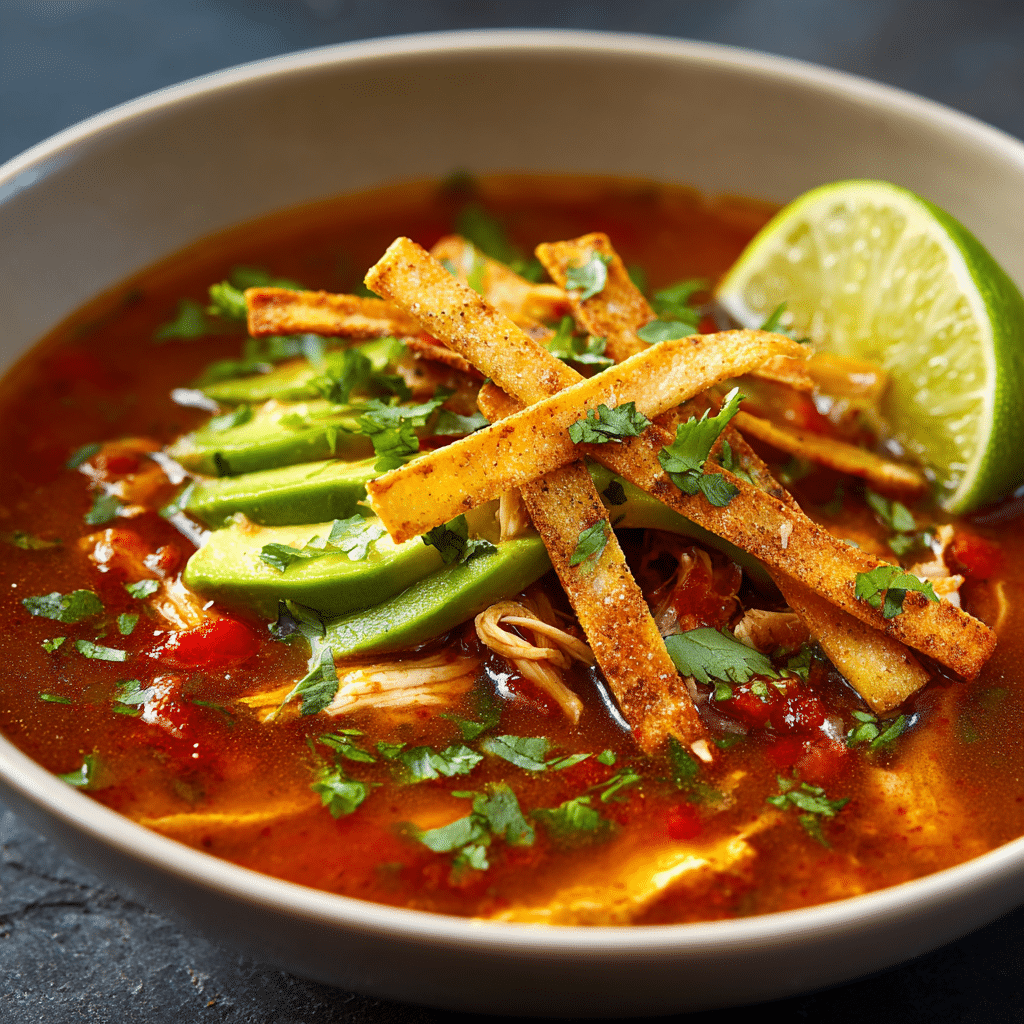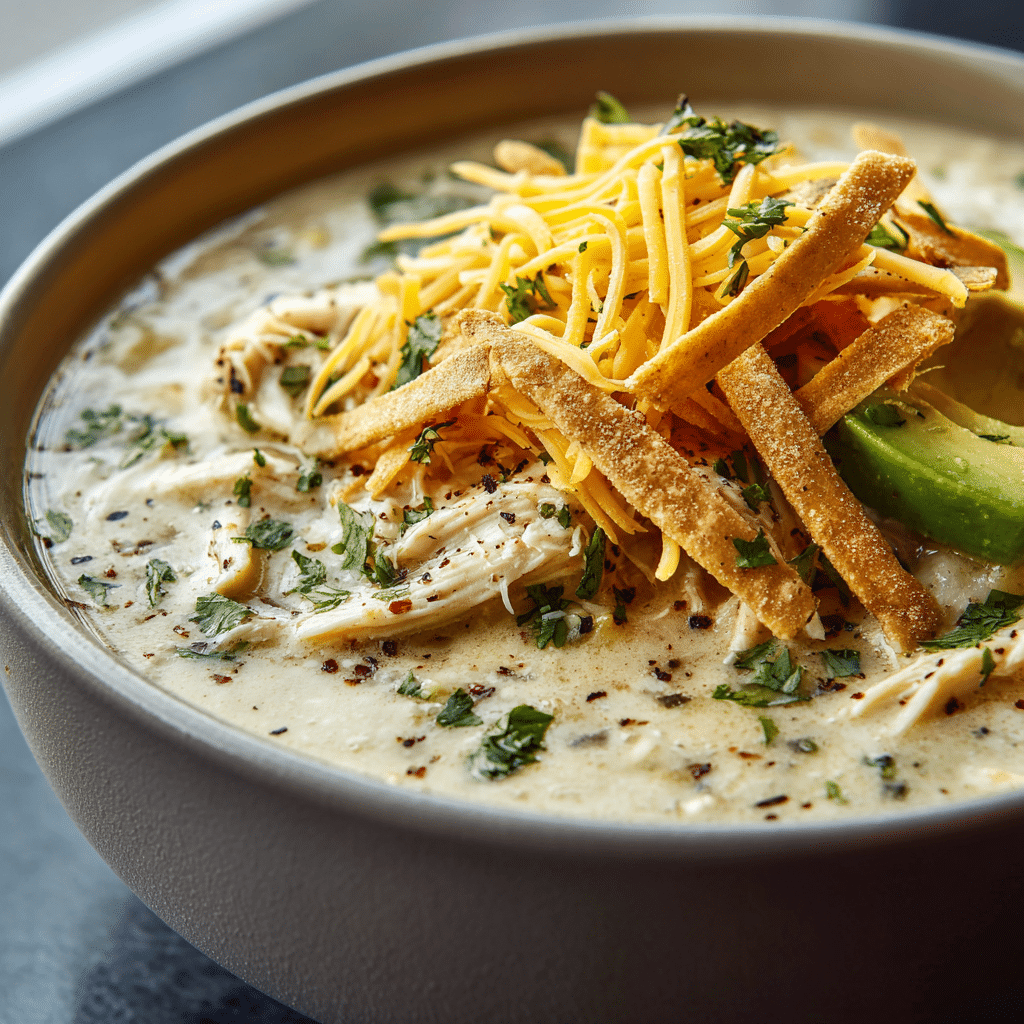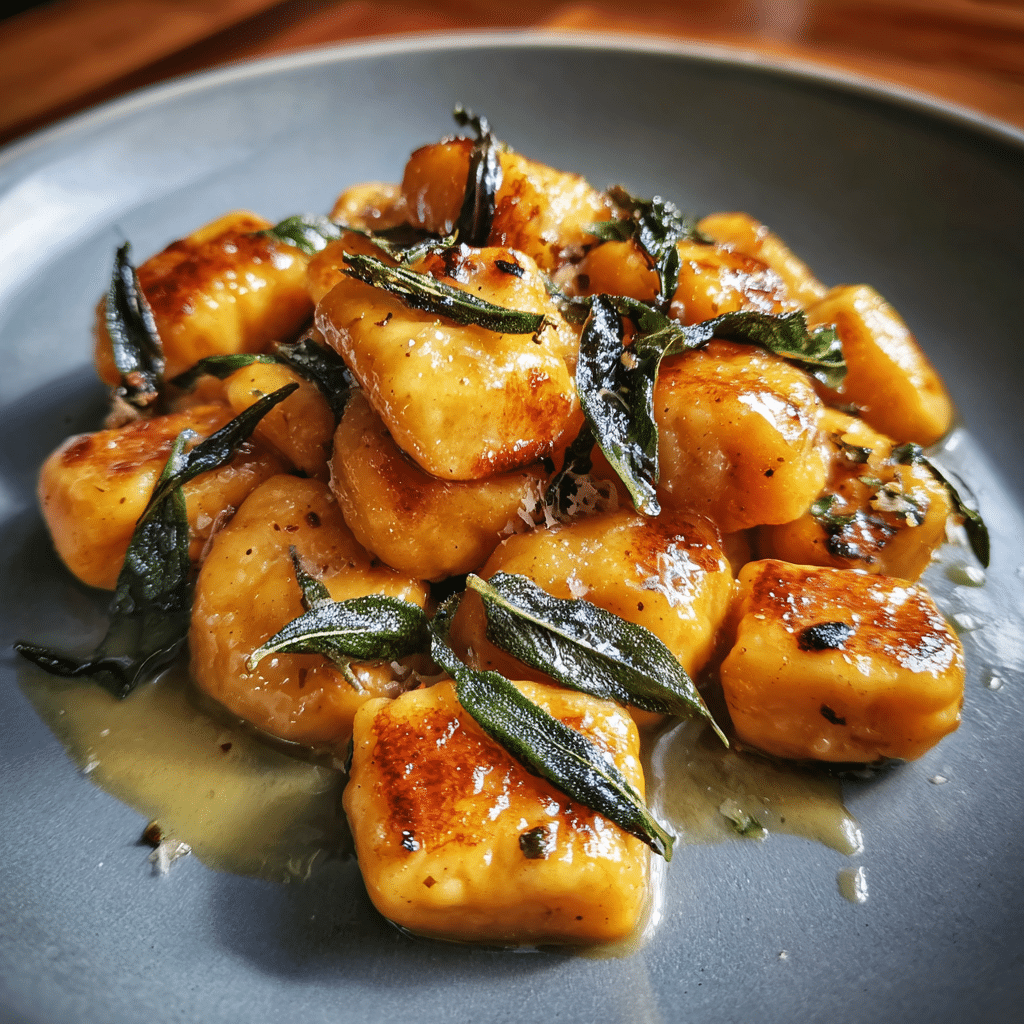Pasta lovers, meet your new weeknight favorite: Spaghetti Aglio e Olio with Green Olives. This dish brings the familiar comfort of garlicky spaghetti and gives it a fresh upgrade with the briny bite of green olives. Whether you’re craving a quick dinner or hosting a casual gathering, this pasta hits all the right notes—savory, simple, and full of character.
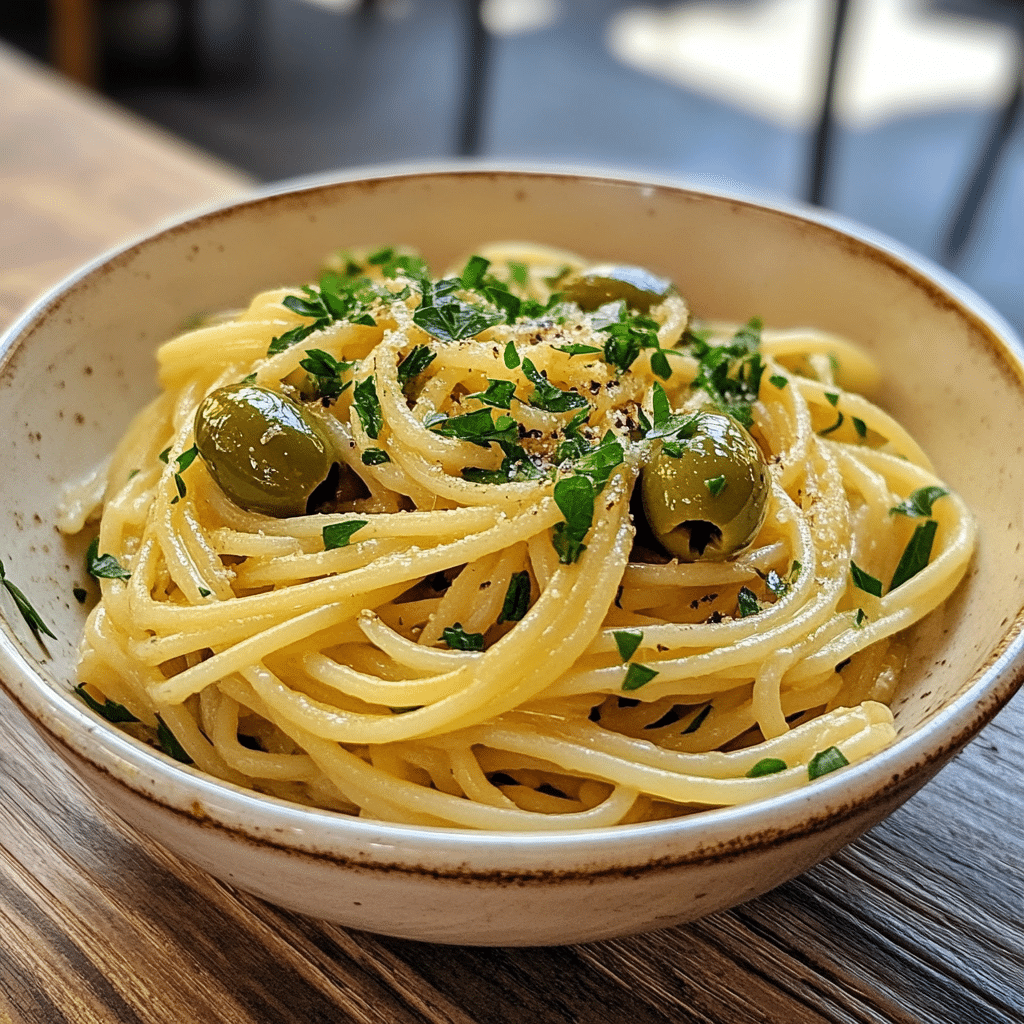
In this article, we’ll break down everything you need to know about making spaghetti aglio e olio with green olives. From the ingredients to helpful cooking tips and serving ideas, we’ve got it covered. We’ll also answer popular questions like whether olives work in pasta sauces, and how to boost flavor without overcomplicating things.
By the end, you’ll not only know how to cook this rustic Italian dish but also how to store leftovers, avoid common mistakes, and customize it to your taste. If you’ve ever made aglio e olio and thought it needed something more, green olives might be your answer.
Table of Contents
Introduction to Spaghetti Aglio e Olio with Green Olives
What is Spaghetti Aglio e Olio?
Spaghetti aglio e olio is one of Italy’s most iconic pasta recipes. Originating from Naples, it’s known for its minimal ingredients and maximum flavor. The base consists of spaghetti tossed with garlic sautéed in olive oil, often finished with a sprinkle of red pepper flakes and fresh parsley. No fancy sauces or long prep time—just pure, honest flavor.
It’s often enjoyed as a late-night snack or a go-to comfort food because it’s fast, budget-friendly, and utterly satisfying. In its simplicity lies its charm.
Why Add Green Olives to Aglio e Olio?
Here’s where things get interesting. Adding green olives to spaghetti aglio e olio introduces a salty, tangy contrast that amplifies the dish’s richness. It’s a natural fit—olives bring a punch of umami and pair beautifully with the garlic and olive oil. This twist isn’t just creative; it enhances the dish in a way that feels both new and timeless.
If you’re already a fan of garlic and oil pasta, the olives take it from good to unforgettable. They add color, complexity, and that extra layer of flavor that makes people ask for seconds.
Ingredients You’ll Need
The Traditional Ingredients
At the heart of any great spaghetti aglio e olio are just a few humble but powerful ingredients. Here’s what you’ll typically find in the classic version:
- Spaghetti: Long, thin, and perfect for holding on to that garlicky oil. You can use whole wheat or gluten-free versions depending on your preference.
- Garlic: The star of the show. Slice it thin to infuse the oil gently without burning.
- Olive Oil: Use high-quality extra virgin olive oil for the richest flavor.
- Red Pepper Flakes: Adds a subtle heat. Adjust to your spice tolerance.
- Parsley: Fresh parsley brings a burst of color and a mild herbal note.
- Salt and Pasta Water: Reserved pasta water helps create a silky sauce that coats every strand.
While the above creates the base, our featured twist—green olives—adds an extra layer that makes the dish stand out.
Choosing the Right Green Olives
Not all green olives are created equal when it comes to cooking. Some varieties are too tart or firm, while others blend seamlessly into the dish. When making spaghetti aglio e olio with green olives, consider the following olive types:
| Olive Type | Flavor Profile | Best Use in Pasta |
|---|---|---|
| Castelvetrano | Mild, buttery | Adds smooth, sweet contrast |
| Manzanilla | Briny, classic flavor | Boosts savory notes |
| Picholine | Tart, crisp | Great for bold flavor balance |
| Stuffed Olives | Salty, varied fillings | Add texture and extra taste |
Always slice the olives before adding them to the pan—this allows them to heat through quickly and meld with the oil and garlic without overpowering the dish.
If you’re looking for a non-traditional pasta topping, green olives are a bold and delicious way to change things up. Their slight bitterness and chewy texture bring out the richness of the oil and garlic combo.
You can see a creative use of savory elements like this in our Creamy Salmon Pasta recipe, where balance is everything.
Step-by-Step Cooking Instructions
How to Prepare the Base (Garlic & Oil)
Making the base of spaghetti aglio e olio with green olives is all about timing and temperature. Here’s how to get it just right:
- Cook the spaghetti in salted boiling water until al dente. Reserve ½ cup of the pasta water before draining.
- While the pasta cooks, slice fresh garlic thinly—this allows it to toast evenly in the oil.
- In a large skillet, heat olive oil over medium-low. Once warm, add the sliced garlic and stir gently. You want it to sizzle softly, not burn.
- Add a pinch of red pepper flakes for heat, stirring them into the oil to release their flavor.
The trick here is patience. Let the garlic turn golden—not brown—so the oil becomes fragrant without bitterness. This garlic oil forms the savory backbone of your dish.
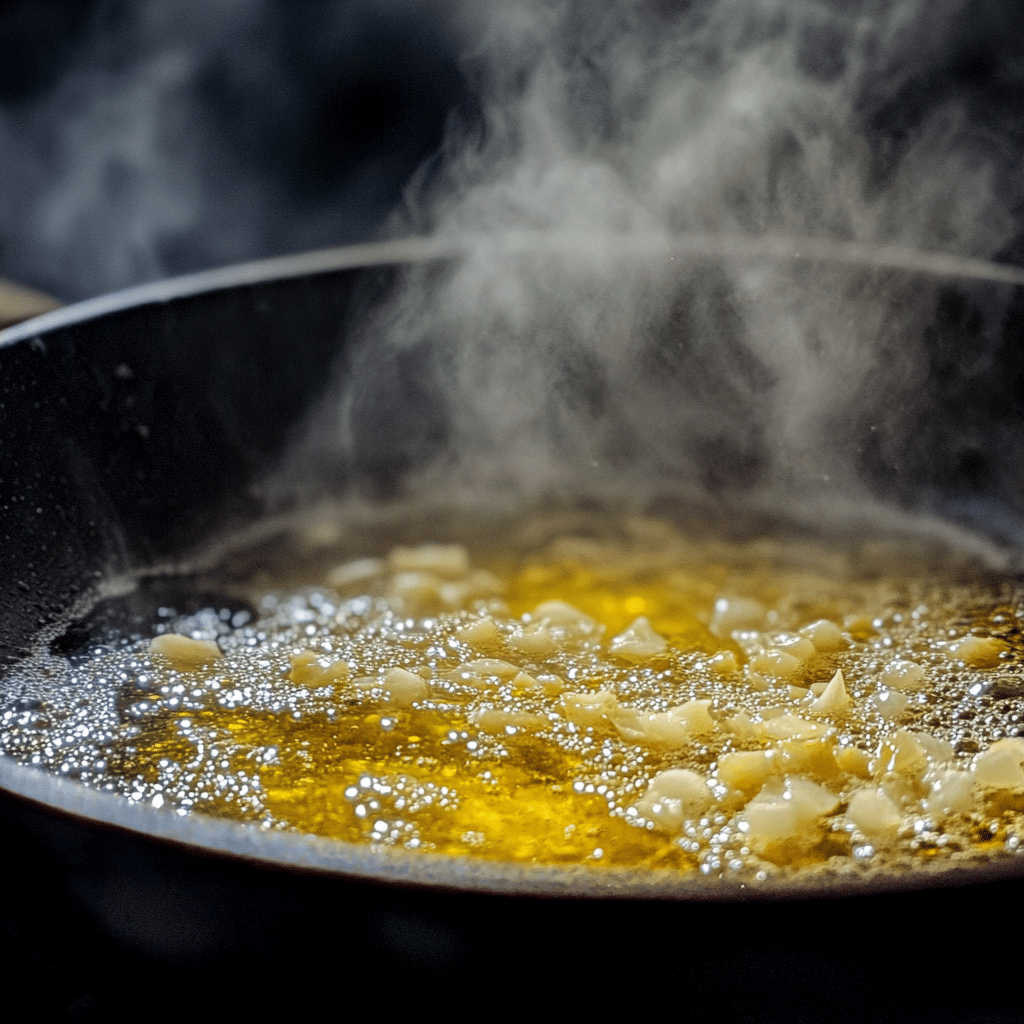
Once you’ve mastered this step, the rest falls into place. You can follow similar base techniques used in recipes like our Salmon Pasta Recipe for building flavor.
When and How to Add Green Olives
Once the garlic is golden, it’s time to fold in the green olives. Make sure they’re pitted and sliced, so they warm quickly and release their briny juices into the oil. Stir them in with the garlic for about 1–2 minutes.
Now, add the drained spaghetti directly into the pan with the olive-garlic mixture. Toss everything together, adding some of the reserved pasta water to help bind the oil and starch into a silky coating.
To finish, sprinkle fresh parsley and a little grated cheese if desired. Taste and adjust with a pinch of salt—remember, olives are naturally salty, so go easy.
This step brings the pasta to life. It’s what makes spaghetti aglio e olio with green olives so addictively good: simple ingredients coming together with bold, unexpected flavor.
And if you enjoy pasta with surprises, try our Pasta Bean Salad for another twist on the traditional.
Cooking Tips for the Best Flavor
Getting the Garlic Just Right
When it comes to spaghetti aglio e olio with green olives, the garlic can make or break your dish. Burned garlic turns bitter fast, and undercooked garlic can taste raw and sharp. Here’s how to do it right:
- Use fresh garlic, not jarred. It’s more flavorful and blends better with olive oil.
- Slice the cloves thin and evenly. This allows them to cook consistently and infuse the oil.
- Cook on medium-low heat. You should see small bubbles around the garlic, not rapid frying.
- Remove the pan from heat as soon as the garlic turns light golden. It will continue to cook from residual heat.
Perfect garlic means perfect flavor. You can take a cue from recipes like our Vegan Pad Thai where ingredient timing matters just as much.
Balancing Saltiness with Olive Brine
Green olives pack a salty punch, which adds depth—but also risk. Too much salt can overpower everything. To balance the saltiness:
- Rinse jarred olives before slicing to tone down the brine.
- Taste before adding extra salt. Pasta water is salty, and so are olives.
- Use fresh parsley or lemon zest to cut the salt with a hint of freshness.
This balance of salt and fat creates a flavor-rich pasta without overwhelming your taste buds. The beauty of spaghetti aglio e olio with green olives lies in getting that balance just right.
If you’re into savory recipes with layered saltiness, check out our Cottage Cheese Pizza Bowl—it’s another unique but delicious take.
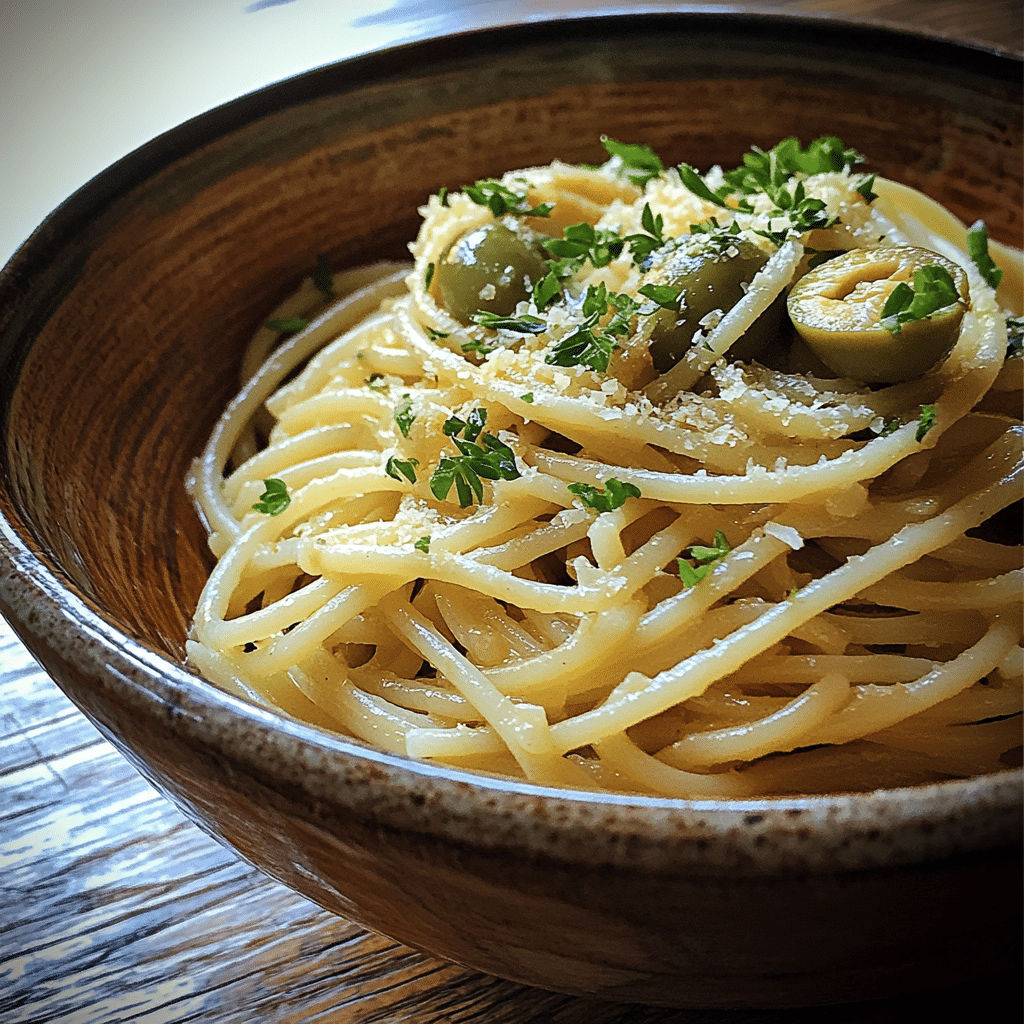
Variations and Creative Add-Ons
Optional Veggies and Herbs to Include
One of the best things about spaghetti aglio e olio with green olives is how easily you can build on it. Once you’ve mastered the base, try tossing in fresh or sautéed vegetables for more color and texture. Here are some crowd-pleasing options:
- Cherry tomatoes: Add them halved for a burst of sweetness.
- Spinach or arugula: Stir in a handful at the end for freshness.
- Zucchini ribbons: Sauté lightly to keep a nice bite.
- Capers: They double down on the briny element, perfect with olives.
Fresh herbs like basil, oregano, or even dill can also change the whole vibe of your pasta. These little twists make it feel new every time.
It’s a lot like our Dark Chocolate Hemp Energy Bites—simple base, endless ways to make it your own.
Protein Additions: Shrimp, Chicken, or Tofu
Want to make your spaghetti aglio e olio with green olives a bit heartier? Add a protein boost. This makes it more filling without taking away from the dish’s rustic charm:
| Protein Option | How to Use | Why It Works |
|---|---|---|
| Shrimp | Pan-seared separately, added at the end | Briny + garlicky = perfect match |
| Grilled Chicken | Sliced thin, added before serving | Adds richness, great for meal prep |
| Tofu | Crisped in olive oil and garlic | Keeps it vegetarian and filling |
Just make sure any added protein is seasoned lightly to complement—not overpower—the garlic and olive oil base.
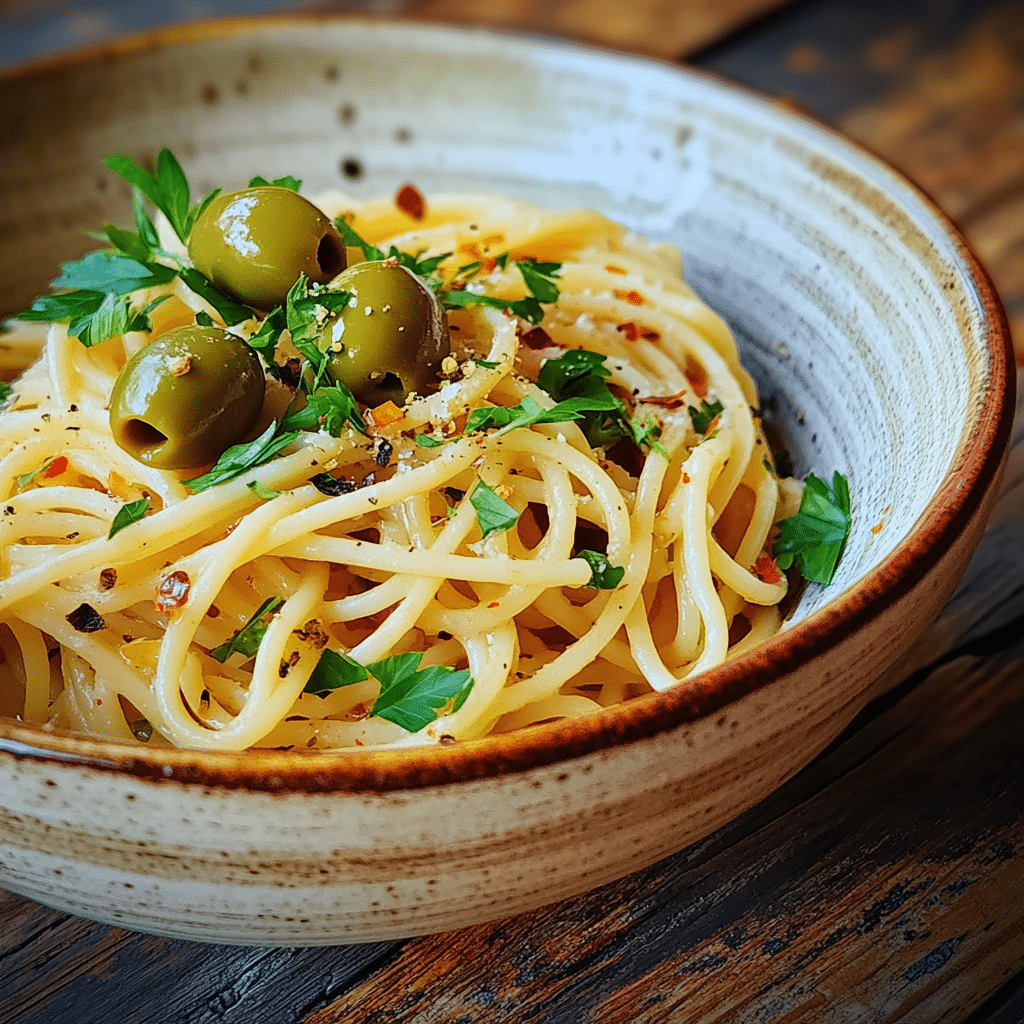
What to Serve with Aglio e Olio and Olives
Best Side Dishes and Breads
While spaghetti aglio e olio with green olives is satisfying on its own, pairing it with the right sides can turn a simple dinner into a full-on feast. The goal is to complement its bold, garlicky flavor with lighter, fresh or crunchy sides.
Here are some favorite pairings:
- Crusty Italian bread or garlic knots to soak up the leftover olive oil and brine.
- Toasted sourdough with a swipe of ricotta for a creamy balance.
- Roasted vegetables like carrots, asparagus, or Brussels sprouts.
- A bowl of clear vegetable soup to contrast the richness of the pasta.
These sides don’t compete—they highlight the flavors of the dish while adding variety in texture and taste. If you’re interested in creative food pairings, our Cottage Cheese Pizza Bowl does something similar with textures and flavors.
Complementary Salads and Beverages
For a refreshing touch, pair your spaghetti aglio e olio with green olives with crisp, acidic sides and light drinks. A few ideas:
- Caesar salad: Anchovy and garlic dressings match well with olives and pasta.
- Arugula salad with lemon vinaigrette: The bitterness of the greens cuts through the oil.
- Greek salad: Olives, tomatoes, and feta echo the Mediterranean profile.
For drinks, think clean and dry:
- Sparkling water with lemon
- Light white wine like Pinot Grigio
- A non-alcoholic mojito or herbal iced tea
Pairing thoughtfully can elevate even a humble bowl of pasta into a cozy, complete experience. You’ll find this layering technique in dishes like our Sizzling Spaghetti, where sides help round out the meal.
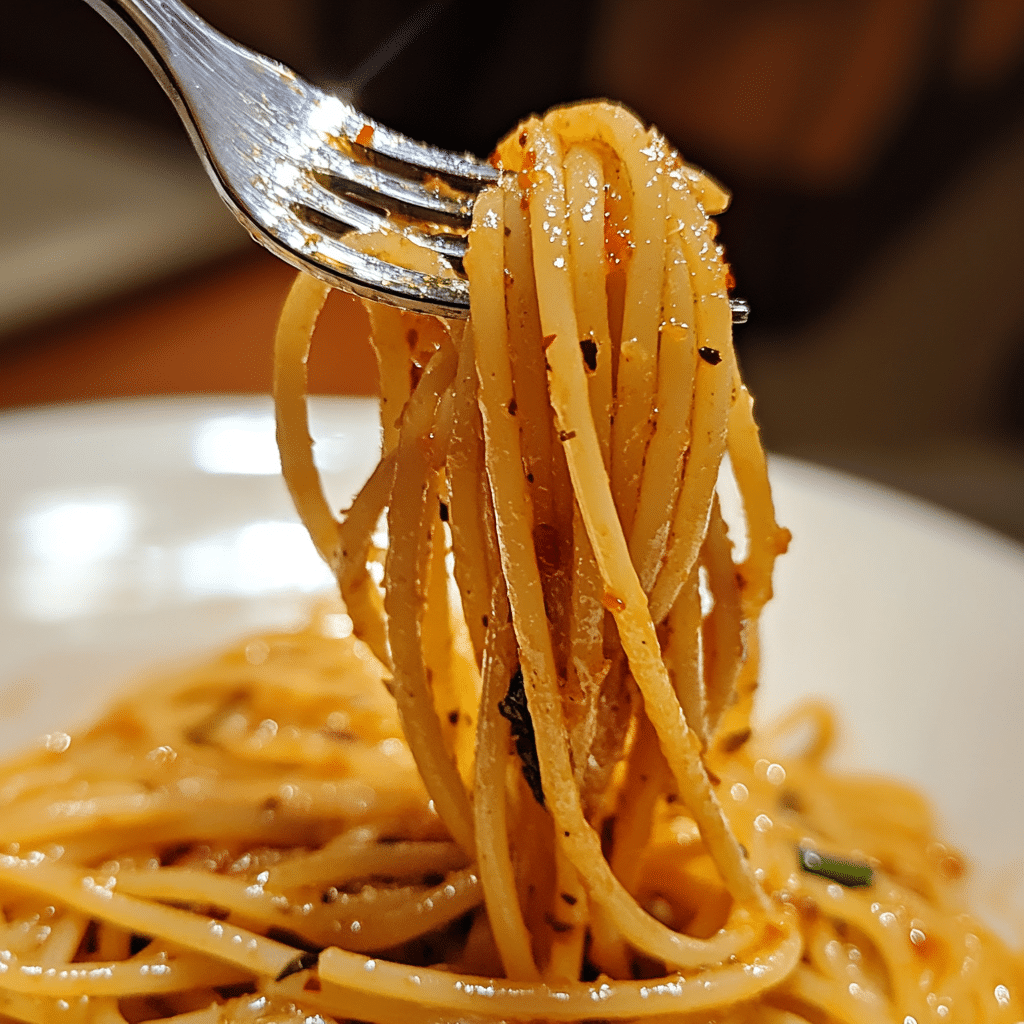
Storing and Reheating Leftovers
Best Practices for Refrigerating Pasta
If you have extra spaghetti aglio e olio with green olives, don’t worry—it stores better than you might think. The olive oil helps keep the pasta moist, while the green olives retain their bold flavor even after chilling.
Here’s how to store it right:
- Cool it quickly: Let the pasta come to room temperature before storing.
- Use an airtight container: Keeps the flavors locked in and avoids fridge odors.
- Refrigerate within two hours: This helps prevent bacteria growth and keeps it fresh.
Stored properly, your garlic olive spaghetti can last up to three days in the fridge. Be sure to label the container with the date, especially if you plan to prep meals ahead.
This dish handles leftovers similarly to our Smoked Mac and Cheese, which also benefits from olive oil’s moisture-locking powers.
How to Reheat Without Losing Texture
Reheating spaghetti aglio e olio with green olives is easy, but technique matters. Avoid the microwave if you can—it dries the pasta and dulls the flavors.
Instead, try this stovetop method:
- Heat a skillet on medium-low.
- Add a splash of olive oil and a little water or broth.
- Toss in the cold pasta and stir gently until heated through.
This keeps the pasta silky and prevents it from drying out. If you notice it’s a bit flat in flavor, add a touch more garlic, crushed red pepper, or a squeeze of lemon to wake it up.
If you enjoy reheating-friendly meals, this one is just as forgiving as our Hot Honey Popcorn Chicken Bites, which also shine the next day.
Common Mistakes and How to Avoid Them
Overcooking Garlic or Pasta
One of the most common slip-ups when making spaghetti aglio e olio with green olives is overcooking either the garlic or the pasta. Both play key roles in texture and flavor, so a misstep here can throw off the whole dish.
Avoid burning the garlic by cooking it on low heat and pulling the pan off the burner once it turns golden. Burned garlic tastes bitter and can ruin the olive oil it sits in.
As for the pasta, keep it firm to the bite—al dente is the goal. Overcooked spaghetti becomes mushy and won’t hold up well when tossed with oil and olives.
To help time it right, always start cooking the garlic when the pasta is about halfway done. That way, both elements finish around the same time.
This kind of attention to detail is why even simple recipes like our Marinated Red Onions stand out—they respect the ingredients and their timing.
Using the Wrong Type of Olive
Not all olives work in this dish. Some can be too bitter, too firm, or overpowering. If you’ve ever tried spaghetti aglio e olio with green olives and found the flavor too strong, the olives are likely to blame.
Stick with these olive types:
- Castelvetrano for a buttery taste
- Manzanilla for classic briny flavor
- Stuffed green olives if you want an extra kick (like garlic or pimento)
Avoid canned olives that are too soft—they tend to turn mushy when heated. Also, steer clear of overly bitter or spicy varieties unless you’re familiar with how they behave in warm dishes.
Print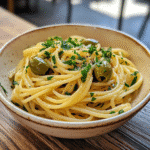
Spaghetti Aglio e Olio with Green Olives: A Bold Twist on a Classic
- Total Time: 20 minutes
- Yield: 2 servings 1x
- Diet: Vegan
Description
A quick and bold twist on the classic Italian spaghetti aglio e olio, this version includes green olives for a briny, savory punch that pairs perfectly with garlic and olive oil.
Ingredients
8 oz spaghetti
4 tbsp extra virgin olive oil
5 cloves garlic, thinly sliced
1/2 tsp red pepper flakes
1/3 cup green olives, sliced
Salt to taste
2 tbsp chopped fresh parsley
1/4 cup reserved pasta water
Instructions
1. Boil pasta in salted water until al dente. Reserve 1/4 cup pasta water.
2. While pasta cooks, heat olive oil in a skillet over medium-low heat.
3. Add sliced garlic and cook until golden, about 2–3 minutes.
4. Stir in red pepper flakes and sliced green olives. Cook for 1–2 minutes.
5. Drain pasta and add to skillet. Toss with oil, garlic, and olives.
6. Add a splash of reserved pasta water to loosen the sauce.
7. Stir in fresh parsley and adjust salt if needed.
8. Serve immediately with optional grated cheese or lemon zest.
Notes
Use Castelvetrano or Manzanilla olives for best flavor.
To make it vegan, skip cheese garnish.
Add shrimp, tofu, or chicken to make it more filling.
- Prep Time: 5 minutes
- Cook Time: 15 minutes
- Category: Dinner
- Method: Stovetop
- Cuisine: Italian
Nutrition
- Serving Size: 1 plate
- Calories: 420
- Sugar: 1g
- Sodium: 500mg
- Fat: 18g
- Saturated Fat: 2.5g
- Unsaturated Fat: 14g
- Trans Fat: 0g
- Carbohydrates: 50g
- Fiber: 3g
- Protein: 8g
- Cholesterol: 0mg
Choosing the right olive is as important as choosing good cheese in our Pimento Cheese Stuffed Pretzel Bites—both make or break the final bite.
FAQs About Spaghetti Aglio e Olio with Green Olives
Can I put olives in aglio olio?
Absolutely! Adding olives—especially green ones—brings a salty, savory contrast that pairs beautifully with garlic and oil. They add both flavor and texture without complicating the dish.
Are green olives good in spaghetti sauce?
Yes, green olives are great in spaghetti sauces. Their briny bite works well with both light and rich sauces. In this garlic oil-based pasta, they provide a punch of flavor that balances the richness of the olive oil.
How to make aglio olio more flavorful?
Use fresh garlic and high-quality extra virgin olive oil. Adding a touch of chili flakes, lemon zest, fresh herbs, or umami boosters like anchovies or olives can enhance the depth. Don’t forget to reserve some pasta water to help the sauce cling.
What pairs well with aglio e olio?
Crusty bread, roasted veggies, or a bright arugula salad go great with aglio e olio. Light wines or sparkling water with citrus also make for excellent beverage pairings.
Conclusion: Make Spaghetti Aglio e Olio with Green Olives Tonight
Spaghetti aglio e olio with green olives proves that simple ingredients can still bring bold flavor. With just pasta, garlic, olive oil, and a handful of briny olives, you get a dish that’s savory, comforting, and fast enough for any night of the week.
Whether you’re going for a traditional take or adding your own twist with herbs, veggies, or proteins, this recipe adapts to your kitchen and your cravings. Just remember: the key lies in good ingredients and careful timing.
Looking for more quick and flavorful dinners? Try our One Pan Cheesy Taco Pasta Bake for another easy weeknight win.
Love simple, bold recipes like this one? Follow me on Pinterest and Medium for more kitchen inspiration and easy pasta ideas every week.


